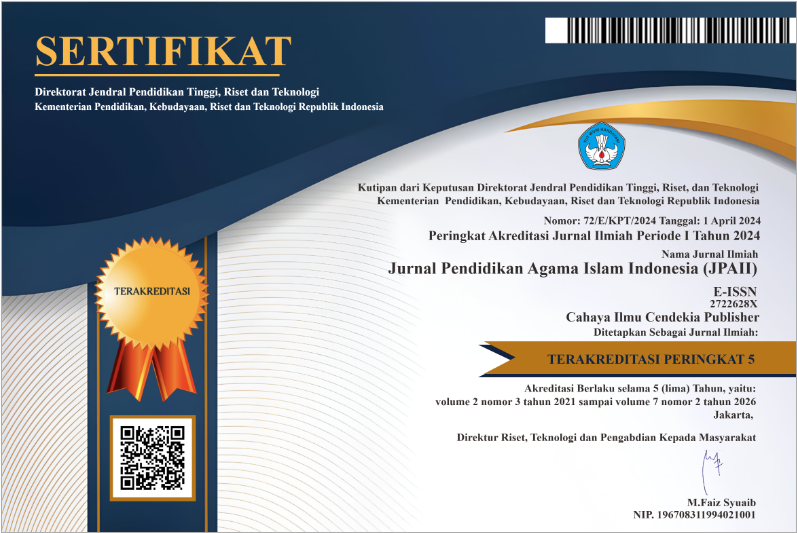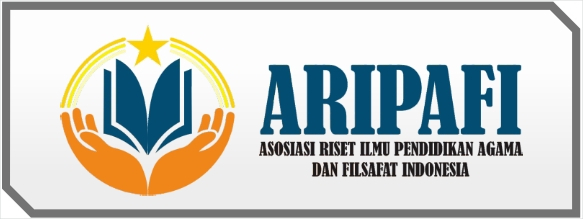The Example of an Islamic Religious Education Teacher on the Awareness of Muslim Women's Dress in Middle School Students
Abstract
Purpose of the study: The aim of the research is to analyze the example of Islamic Religious Education Teachers on the Awareness of Muslim Women's Dress in Students at Junior High School Negeri 4 Panca Rijang, Sidrap Regency
Methodology: The method used is quantitative with a case study type of research, the research location is at Junior High School Negeri 4 Panca Rijang Sidrap Regency. The instrument used is a questionnaire with descriptive data analysis.
Main Findings: Based on the results of descriptive statistical analysis of questionnaire scores related to the variable awareness of Muslim women's clothing of students from 54 respondents, it is known that students who stated that awareness of Muslim women's clothing were in the very poor category were 0 (0%), students who stated that it was bad was 0 (0%) %) people, students who said it was fair were 3 (6%) people, students who said it was good were 32 (59%) people, and students who said their awareness of Muslim women's clothing was in the very good category was 19 (35% ) person.
Novelty/Originality of this study: The latest research is trying to examine the awareness of Muslim women's clothing at Junior High School Negeri 4 Panca Rijang, Sidrap Regency.
References
M. S. Muchith, “Guru PAI Yang Profesional,” Quality, vol. 4, no. 2, pp. 217–235, 2016.
E. Kuswanto, “Peranan Guru PAI dalam Pendidikan Akhlak di Sekolah,” MUDARRISA J. Islam. Educ., vol. 6, no. 2, p. 194, 2015, doi: 10.18326/mdr.v6i2.194-220.
A. C. Budiati, “Jilbab: Gaya Hidup Baru Kaum Hawa,” J. Sosiol. Islam, vol. 1, no. 1, pp. 59–70, 2011.
S. Alawiyah, B. Handrianto, and I. Kania Rahman, “Adab Berpakaian Wanita Muslimah Sesuai Tuntunan Syariat Islam,” Rayah Al-Islam, vol. 4, no. 02, pp. 218–228, 2020, doi: 10.37274/rais.v4i02.338.
Wahyu Ziaulhaq and M. Idris, “Sosialisasi Penggunaan Pakaian Syar’I Terhadap Siswa-Siswi Melalui Pendekatan Persuasif Di Madrasah Aliyah Persiapan Negeri Besitang,” SABANA J. Sosiologi, Antropol. dan Budaya Nusant., vol. 1, no. 1, pp. 20–27, 2020, doi: 10.55123/sabana.v1i1.239.
M. I. Arief and G. M. I. Husin, “Agama Dan Sistem Pendidikan Nasional (Kasus Pelarangan Jilbab di Sekolah),” DARUL ULUM J. Ilm. Keagamaan, Pendidik. dan Kemasyarakatan, vol. 10, no. 2, 2019.
W. Ziaulhaq and L. Handayani, “Pelaksanaan Transfer Pesan Persuasif Guru dalam Menyeru kepada Siswa-Siswi agar Menggunakan Pakaian Syar’i pada Madrasah Aliyah Persiapan Negeri Besitang,” J. Indones. Cult. Beliefs, vol. 1, no. 1, pp. 53–64, 2022, doi: 10.55927/jicb.v1i1.1418.
M. Rifki, S. Sauri, A. Aam, S. Udin, and M. Parid, “Pengembangan Karakter Religius Peserta Didik Berbasis Keteladanan Guru Dalam Pembelajaran Pai,” no. 1, pp. 1–14, 2004.
D. Harmita, D. Nurbika, and A. Asiyah, “Keteladanan Guru Pendidikan Agama Islam dalam Internalisasi Nilai-Nilai Akhlakul Karimah pada Siswa,” J. Educ. Instr., vol. 5, no. 1, pp. 114–122, 2022, doi: 10.31539/joeai.v5i1.3231.
N. B. Zulfatmi, “Integrasi Nilai Karakter Dalam Pembelajaran Berbasis Kurtilas (Kajian Peran Keteladanan Guru PAI Madrasah Aliyah di Aceh),” J. MUDARRISUNA Media …, pp. 696–714, 2020, [Online]. Available: https://jurnal.ar-raniry.ac.id/index.php/mudarrisuna/article/view/8737.
H. M. F. Aladdin, “Peran Materi Pendidikan Agama Islam di Sekolah dalam Membentuk Karakter Kebangsaan,” J. Penelit. Medan Agama, vol. 10, no. 2, p. 153, 2019, [Online]. Available: http://jurnal.uinsu.ac.id/index.php/medag/article/view/6417/3050.
H. Rahmat, M. Sarbini, and A. Maulida, “Peran Guru Pendidikan Agama Islam Dan Budi Pekerti Dalam Membentuk Kepribadian Siswa Smk Al-Bana Cilebut Bogor,” Pros. Al Hidayah Pendidik. Agama Islam, pp. 146–157, 2018, [Online]. Available: http://jurnal.staialhidayahbogor.ac.id/index.php/ppai/article/view/331.
S. Luckyardi, H. Saputra, N. Safitri, A. Cahyaningrum, D. Septiani, and R. Hidayat, “Perancangan Sistem Informasi Penjualan Busana Muslim Berbasis Web,” IJIS - Indones. J. Inf. Syst., vol. 6, no. 2, pp. 156–168, 2021, doi: 10.36549/ijis.v6i2.165.
Suna, A. Susandi, and D. Muhammad, “Etika Dan Estetika Berbusana Muslimah,” jpdk, vol. 4, no. 1, 2022, [Online]. Available: https://aks-akk.e-journal.id/jsa/article/view/68/34.
M. Rifki, S. Sauri, A. Abdussalam, U. Supriadi, and M. Parid, “Internalisasi Nilai-Nilai Karakter melalui Metode Keteladanan Guru di Sekolah,” J. Basicedu, vol. 7, no. 1, pp. 89–98, 2023, doi: 10.31004/basicedu.v7i1.4274.
D. Alderson, J. Charles & Wall, “Penelitian Survei Dalam Pembelajaran Dan Pengajaran Bahasa Inggris,” Japanese Soc. Biofeedback Res., vol. 19, no. August, pp. 709–715, 1992.
A. F. Hayes and K. J. Preacher, “Statistical mediation analysis with a multicategorical independent variable,” Br. J. Math. Stat. Psychol., vol. 67, no. 3, pp. 451–470, 2014, doi: 10.1111/bmsp.12028.
S. W. Octavia, N. Septiani, F. Sinaga, and N. N. Qoidah, “Analysis Of The Relationship In Learning Interest To Learning Outcomes Static Fluid Material In Senior High School,” Aleph, vol. 87, no. 1,2, pp. 149–200, 2023.
J. G. March and R. I. Sutton, “Organizational Performance as a Dependent Variable,” Organ. Sci., vol. 8, no. 6, 1997.
Amirotun Sholikhah, “Statistik Deskriptif Dalam Penelitian Kualitatif,” Komun. Islam, vol. 10, no. No. 2 (2016), pp. 1–21, 2016.
F. T. Aldila, E. F. S. Rini, Sri Wina Oktavia, N. N. Khaidah, F. P. Sinaga, and N. Septiani, “Edufisika : Jurnal Pendidikan Fisika Volume 8 Number 1 , April 2023,” Edufisika J. Pendidik. Fis., vol. 8, no. 1, pp. 101–105, 2023, doi: 10.59052/edufisika.v8i1.24864.
Astalini, Darmaji, D. A. Kurniawan, S. W. Oktavia, E. Triani, and M. Z. Azzahra, “The Exploration of Character Values in Physics Learning on Momentum , Impulse , and Collision Materials,” J. Educ. Res. Eval., vol. 7, no. 2, pp. 277–284, 2023, doi: https://doi.org/10.23887/jere.v7i2.52381.
Copyright (c) 2023 Nurhikmah Amrah

This work is licensed under a Creative Commons Attribution-NonCommercial 4.0 International License.
Authors who publish with this journal agree to the following terms:
- Authors retain copyright and acknowledge that the Jurnal Pendidikan Agama Islam Indonesia (JPAII) is the first publisher licensed under a Creative Commons Attribution 4.0 International License.
- Authors are able to enter into separate, additional contractual arrangements for the non-exclusive distribution of the journal's published version of the work (e.g., post it to an institutional repository or publish it in a book), with an acknowledgment of its initial publication in this journal.
- Authors are permitted and encouraged to post their work online (e.g., in institutional repositories or on their website) prior to and during the submission process, as it can lead to productive exchanges and earlier and greater citation of published work.






.png)
.png)





















